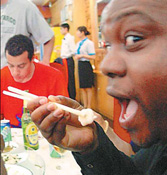Learning how to use chopsticks is usually one of the first lessons expats undertake in their China experience.
China's culinary obsession has grown ever stronger through history, cementing the iconic status of the pair of thin sticks that hold the key to sampling the vast and complex array of dishes served up in the Middle Kingdom.
In the right hands, chopsticks are a simple and elegant means of parlaying those tasty morsels from the table to your mouth, eliminating the need to switch between various metal implements, as it is done in the West with knife and fork.
Confucius, the father of Chinese thought, has been credited with spurring the widespread and lasting adoption of chopsticks by equating knives with acts of aggression, anathema to his peaceful teachings:
"The honorable and upright man keeps well away from both the slaughterhouse and the kitchen. And he allows no knives on his table."
Perhaps evolving from twigs used to spear food over an open fire, chopsticks were in use by the Shang Dynasty (16th-11th century BC) and have been the favored utensil throughout China since the Han Dynasty (206 BC-AD 220).
During the Middle Ages, aristocrats favored silver chopsticks since it was thought the precious metal would change color on coming into contact with poison. Today, they are most commonly made of unpolished wood or bamboo, though also seen in smooth plastic, lacquer, porcelain, bone or metal.
Chopsticks are the first symbol many foreigners associate with China, and have made their journey around the world as the constant companion to Chinese fare, a firm favorite of diners in countries everywhere.
At home, the Chinese are proud of their dexterity with the twin sticks, and expats living here often find themselves the object of amusement as they struggle to stop grains of rice from escaping their tentative grasp en route from the serving plate.
The enduring appeal of chopsticks extends from the table to the kitchen, where they are used as a cooking implement. Chefs first cut meat and vegetables into tiny pieces, to be thrown into a wok and stir-fried using the sticks, an efficient method cutting down on cooking time and hence fuels.
In Chinese, the word for chopsticks derives its meaning from the character for "fast", which is the way this style of fare is most often devoured. For those more accustomed to a knife and fork, however, using chopsticks can be a good way to slow down the scoffing, and avoid overeating.
Like any true icon, chopsticks have lasted the test of time, proving they are here to stay.
Last year saw the emergence of a new movement among the environmentally conscious, who began taking their own set of re-useable chopsticks to restaurants. This is a way to cut down on the landfill contribution from the countless wooden chopsticks disposed of each day, and another indication of the enduring popularity of the pair of simple sticks that is so integral to life in China.
(China Daily January 14, 2008)


